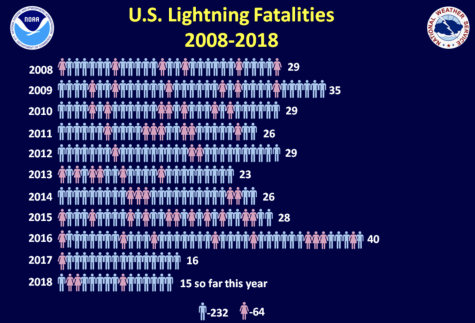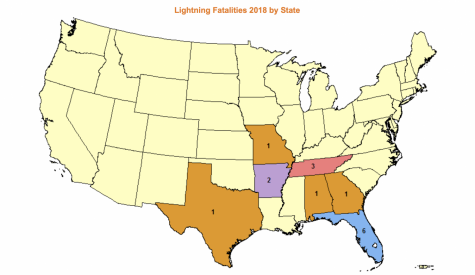More people have died in the first seven months of 2018 than all of 2017. Although lightning strike fatalities vary from year to year, this year has already hit the state’s average of 5, according to the National Oceanic and Atmospheric Administration.
According to the NOAA, lightning has already killed six people this year and it is only halfway through the storm season.
John Jensenius, NOAA’s specialist and national spokesperson for lightning safety, found that there is no significant data that would indicate that there are more storms or more lightning than normal, but people are being struck by lightning at a high rate than normal.

“People take chances, simply because they take chances they get struck by lightning,” Jensenius said. “Sometimes it’s a matter of luck and people taking chances.”
On average, Florida has 3,500 cloud-to-ground lightning flashes per day and 1.2 million flashes per year occur, the NOAA has reported. In other words, Florida averages more lightning than any other state in the U.S. due to its humidity and heat, which are both huge factors in storms. The heat allows for air to rise, and the humidity causes the lightning and precipitation.
Florida is reportedly more vulnerable to storms simply because of its location and shape. Florida is a peninsula, and by default, it has more beaches. The sea breeze, or push of air from the ocean, usually brings a drop in temperature or humidity level during the daytime.

Jensenius explained how Florida’s weather attracts people to go outside. There are many factors that go into why people are in Florida and outside: many people partake in outdoor activities or have employment outside. Additionally, tourism brings people to Florida in the stormy season.
Jensenius told Spinnaker he just wants people to be more aware of the danger a normal Florida afternoon storm can bring. Staying safe and being aware of lightning is the only thing you can do to prevent being struck by lightning.
“You cannot ignore the danger,” Jensenius said.
Jensenius suggests that people should go inside if they see a storm rolling in or a suspicious cloud, even when they cannot hear thunder. He also suggests that people follow the lightning safety rules because it is not worth taking a chance.
NOAA’s lightning safety rules:
- If you hear thunder, lightning is close enough to strike you.
- Shelter includes a car with a metal top, a substantial building or beach bathroom if nothing else is available.
- Stay off corded phones, computers and other electrical equipment that put you in direct contact with electricity.
- Avoid plumbing, including sinks, baths and faucets.
- Stay away from windows and doors, and stay off porches.
- Do not lie on concrete floors, and do not lean against concrete walls which may include metal.
- Immediately get off elevated areas such as hills, mountain ridges or peaks.
- Never lie flat on the ground.
- Never shelter under an isolated tree.
- Never use a cliff or rocky overhang for shelter.
- Immediately get out of and away from ponds, lakes and other bodies of water.
- Stay away from objects that conduct electricity (barbed wire fences, power lines, windmills, etc.).
—
For more information or news tips, or if you see an error in this story or have any compliments or concerns, contact editor@unfspinnaker.com











